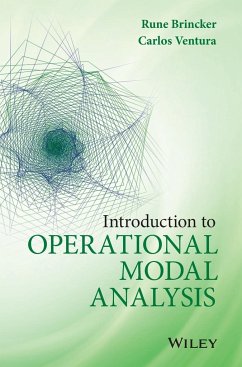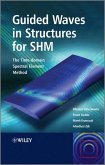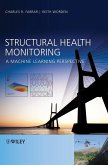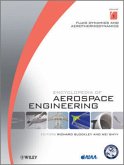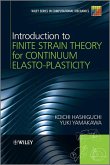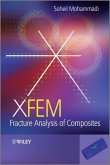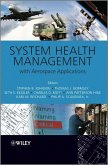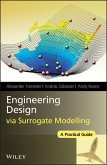- Gebundenes Buch
- Merkliste
- Auf die Merkliste
- Bewerten Bewerten
- Teilen
- Produkt teilen
- Produkterinnerung
- Produkterinnerung
Comprehensively covers the basic principles and practice of Operational Modal Analysis (OMA).
Covers all important aspects that are needed to understand why OMA is a practical tool for modal testing Covers advanced topics, including closely spaced modes, mode shape scaling, mode shape expansion and estimation of stress and strain in operational responses Discusses practical applications of Operational Modal Analysis Includes examples supported by MATLAB® applications Accompanied by a website hosting a MATLAB® toolbox for Operational Modal Analysis
Andere Kunden interessierten sich auch für
![Guided Waves in Structures for SHM Guided Waves in Structures for SHM]() Wieslaw OstachowiczGuided Waves in Structures for SHM162,99 €
Wieslaw OstachowiczGuided Waves in Structures for SHM162,99 €![Structural Health Monitoring Structural Health Monitoring]() Charles R. FarrarStructural Health Monitoring184,99 €
Charles R. FarrarStructural Health Monitoring184,99 €![Encyclopedia of Aerospace Engineering, 9 Volume Set Encyclopedia of Aerospace Engineering, 9 Volume Set]() Richard BlockleyEncyclopedia of Aerospace Engineering, 9 Volume Set4.847,99 €
Richard BlockleyEncyclopedia of Aerospace Engineering, 9 Volume Set4.847,99 €![Introduction to Finite Strain Theory for Continuum Elasto-Plasticity Introduction to Finite Strain Theory for Continuum Elasto-Plasticity]() Koichi HashiguchiIntroduction to Finite Strain Theory for Continuum Elasto-Plasticity179,99 €
Koichi HashiguchiIntroduction to Finite Strain Theory for Continuum Elasto-Plasticity179,99 €![Xfem Fracture Analysis of Composites Xfem Fracture Analysis of Composites]() Soheil MohammadiXfem Fracture Analysis of Composites173,99 €
Soheil MohammadiXfem Fracture Analysis of Composites173,99 €![System Health Management System Health Management]() System Health Management270,99 €
System Health Management270,99 €![Engineering Design Via Surrogate Modelling Engineering Design Via Surrogate Modelling]() Alexander ForresterEngineering Design Via Surrogate Modelling163,99 €
Alexander ForresterEngineering Design Via Surrogate Modelling163,99 €-
-
-
Comprehensively covers the basic principles and practice of Operational Modal Analysis (OMA).
Covers all important aspects that are needed to understand why OMA is a practical tool for modal testing
Covers advanced topics, including closely spaced modes, mode shape scaling, mode shape expansion and estimation of stress and strain in operational responses
Discusses practical applications of Operational Modal Analysis
Includes examples supported by MATLAB® applications
Accompanied by a website hosting a MATLAB® toolbox for Operational Modal Analysis
Hinweis: Dieser Artikel kann nur an eine deutsche Lieferadresse ausgeliefert werden.
Covers all important aspects that are needed to understand why OMA is a practical tool for modal testing
Covers advanced topics, including closely spaced modes, mode shape scaling, mode shape expansion and estimation of stress and strain in operational responses
Discusses practical applications of Operational Modal Analysis
Includes examples supported by MATLAB® applications
Accompanied by a website hosting a MATLAB® toolbox for Operational Modal Analysis
Hinweis: Dieser Artikel kann nur an eine deutsche Lieferadresse ausgeliefert werden.
Produktdetails
- Produktdetails
- Verlag: Wiley & Sons
- 1. Auflage
- Seitenzahl: 372
- Erscheinungstermin: 15. September 2015
- Englisch
- Abmessung: 250mm x 175mm x 25mm
- Gewicht: 826g
- ISBN-13: 9781119963158
- ISBN-10: 111996315X
- Artikelnr.: 39560910
- Herstellerkennzeichnung
- Libri GmbH
- Europaallee 1
- 36244 Bad Hersfeld
- gpsr@libri.de
- Verlag: Wiley & Sons
- 1. Auflage
- Seitenzahl: 372
- Erscheinungstermin: 15. September 2015
- Englisch
- Abmessung: 250mm x 175mm x 25mm
- Gewicht: 826g
- ISBN-13: 9781119963158
- ISBN-10: 111996315X
- Artikelnr.: 39560910
- Herstellerkennzeichnung
- Libri GmbH
- Europaallee 1
- 36244 Bad Hersfeld
- gpsr@libri.de
Rune Brincker is a civil engineer and received his M.Sc and Ph.D. from the Technical University of Denmark in 1977 and 1981, respectively. Since then he has been conducting research on various aspects of structural mechanics. Rune has been employed as associate and full professor at several Danish universities. Presently he is a Professor of Structural Dynamics at Aarhus University, Denmark. During the last 30 years his research has been focused on operational modal analysis (OMA), and one of his major contributions to this field has been the development of the frequency domain decomposition (FDD) identification technique, which has been used in many practical applications of OMA. Rune Brincker is a co-founder of Structural Vibration Solutions (SVS) founded in 1999; and he is the founding chair of the International Operational Modal Analysis Conference (IOMAC) which started in 2005. Carlos Ventura is a Civil Engineer with specializations in structural dynamics and earthquake engineering. He has been a faculty member of the Department of Civil Engineering at the University of British Columbia (UBC) in Canada since 1992. He is currently the Director of the Earthquake Engineering Research Facility (EERF) at UBC, and is the author of more than 450 papers and reports on earthquake engineering, structural dynamics and modal testing. He has conducted research about earthquakes and structural dynamics for more than thirty years. In addition to his academic activities, Carlos Ventura is a recognized international consultant on structural vibrations and safety of large Civil Engineering structures. He is a member of the Canadian Academy of Engineering and Fellow of Engineers Canada, also a member of several national and international professional societies, advisory committees and several building and bridge code committees.
Preface xi
1 Introduction 1
1.1 Why Conduct Vibration Test of Structures? 3
1.2 Techniques Available for Vibration Testing of Structures 3
1.3 Forced Vibration Testing Methods 4
1.4 Vibration Testing of Civil Engineering Structures 5
1.5 Parameter Estimation Techniques 5
1.6 Brief History of OMA 6
1.7 Modal Parameter Estimation Techniques 6
1.8 Perceived Limitations of OMA 10
1.9 Operating Deflection Shapes 10
1.10 Practical Considerations of OMA 11
1.11 About the Book Structure 13
References 15
2 Random Variables and Signals 17
2.1 Probability 17
2.1.1 Density Function and Expectation 17
2.1.2 Estimation by Time Averaging 19
2.1.3 Joint Distributions 21
2.2 Correlation 23
2.2.1 Concept of Correlation 23
2.2.2 Autocorrelation 24
2.2.3 Cross Correlation 25
2.2.4 Properties of Correlation Functions 27
2.3 The Gaussian Distribution 28
2.3.1 Density Function 28
2.3.2 The Central Limit Theorem 28
2.3.3 Conditional Mean and Correlation 30
References 31
3 Matrices and Regression 33
3.1 Vector and Matrix Notation 33
3.2 Vector and Matrix Algebra 35
3.2.1 Vectors and Inner Products 35
3.2.2 Matrices and Outer Products 36
3.2.3 Eigenvalue Decomposition 38
3.2.4 Singular Value Decomposition 40
3.2.5 Block Matrices 40
3.2.6 Scalar Matrix Measures 41
3.2.7 Vector and Matrix Calculus 43
3.3 Least Squares Regression 44
3.3.1 Linear Least Squares 44
3.3.2 Bias, Weighting and Covariance 47
References 52
4 Transforms 53
4.1 Continuous Time Fourier Transforms 53
4.1.1 Real Fourier Series 54
4.1.2 Complex Fourier Series 55
4.1.3 The Fourier Integral 58
4.2 Discrete Time Fourier Transforms 59
4.2.1 Discrete Time Representation 59
4.2.2 The Sampling Theorem 62
4.3 The Laplace Transform 66
4.3.1 The Laplace Transform as a generalization of the Fourier Transform 66
4.3.2 Laplace Transform Properties 67
4.3.3 Some Laplace Transforms 68
4.4 The Z-Transform 71
4.4.1 The Z-Transform as a generalization of the Fourier Series 71
4.4.2 Z-Transform Properties 73
4.4.3 Some Z-Transforms 73
4.4.4 Difference Equations and Transfer Function 75
4.4.5 Poles and Zeros 76
References 79
5 Classical Dynamics 81
5.1 Single Degree of Freedom System 82
5.1.1 Basic Equation 82
5.1.2 Free Decays 83
5.1.3 Impulse Response Function 87
5.1.4 Transfer Function 89
5.1.5 Frequency Response Function 90
5.2 Multiple Degree of Freedom Systems 92
5.2.1 Free Responses for Undamped Systems 93
5.2.2 Free Responses for Proportional Damping 95
5.2.3 General Solutions for Proportional Damping 95
5.2.4 Transfer Function and FRF Matrix for Proportional Damping 96
5.2.5 General Damping 99
5.3 Special Topics 107
5.3.1 Structural Modification Theory 107
5.3.2 Sensitivity Equations 109
5.3.3 Closely Spaced Modes 110
5.3.4 Model Reduction (SEREP) 114
5.3.5 Discrete Time Representations 116
5.3.6 Simulation of OMA Responses 119
References 121
6 Random Vibrations 123
6.1 General Inputs 123
6.1.1 Linear Systems 123
6.1.2 Spectral Density 125
6.1.3 SISO Fundamental Theorem 128
6.1.4 MIMO Fundamental Theorem 129
6.2 White Noise Inputs 130
6.2.1 Concept of White Noise 130
6.2.2 Decomposition in Time Domain 131
6.2.3 Decomposition in Frequency Domain 134
6.2.4 Zeroes of the Spectral Density Matrix 137
6.2.5 Residue Form 139
6.2.6 Approximate Residue Form 140
6.3 Uncorrelated Modal Coordinates 143
6.3.1 Concept of Uncorrelated Modal Coordinates 143
6.3.2 Decomposition in Time Domain 144
6.3.3 Decomposition in Frequency Domain 145
References 147
7 Measurement Technology 149
7.1 Test Planning 149
7.1.1 Test Objectives 149
7.1.2 Field Visit and Site Inspection 150
7.1.3 Field Work Preparation 150
7.1.4 Field Work 151
7.2 Specifying Dynamic Measurements 152
7.2.1 General Considerations 152
7.2.2 Number and Locations of Sensors 154
7.2.3 Sampling Rate 158
7.2.4 Length of Time Series 159
7.2.5 Data Sets and References 160
7.2.6 Expected Vibration Level 162
7.2.7 Loading Source Correlation and Artificial Excitation 164
7.3 Sensors and Data Acquisition 168
7.3.1 Sensor Principles 168
7.3.2 Sensor Characteristics 169
7.3.3 The Piezoelectric Accelerometer 173
7.3.4 Sensors Used in Civil Engineering Testing 175
7.3.5 Data Acquisition 179
7.3.6 Antialiasing 182
7.3.7 System Measurement Range 182
7.3.8 Noise Sources 183
7.3.9 Cabled or Wireless Sensors? 187
7.3.10 Calibration 188
7.3.11 Noise Floor Estimation 191
7.3.12 Very Low Frequencies and Influence of Tilt 194
7.4 Data Quality Assessment 196
7.4.1 Data Acquisition Settings 196
7.4.2 Excessive Noise from External Equipment 197
7.4.3 Checking the Signal-to-Noise Ratio 197
7.4.4 Outliers 197
7.5 Chapter Summary - Good Testing Practice 198
References 199
8 Signal Processing 201
8.1 Basic Preprocessing 201
8.1.1 Data Quality 202
8.1.2 Calibration 202
8.1.3 Detrending and Segmenting 203
8.2 Signal Classification 204
8.2.1 Operating Condition Sorting 204
8.2.2 Stationarity 205
8.2.3 Harmonics 206
8.3 Filtering 208
8.3.1 Digital Filter Main Types 209
8.3.2 Two Averaging Filter Examples 210
8.3.3 Down-Sampling and Up-Sampling 212
8.3.4 Filter Banks 213
8.3.5 FFT Filtering 213
8.3.6 Integration and Differentiation 214
8.3.7 The OMA Filtering Principles 216
8.4 Correlation Function Estimation 218
8.4.1 Direct Estimation 219
8.4.2 Biased Welch Estimate 221
8.4.3 Unbiased Welch Estimate (Zero Padding) 222
8.4.4 Random Decrement 224
8.5 Spectral Density Estimation 229
8.5.1 Direct Estimation 229
8.5.2 Welch Estimation and Leakage 229
8.5.3 Random Decrement Estimation 232
8.5.4 Half Spectra 233
8.5.5 Correlation Tail and Tapering 233
References 237
9 Time Domain Identification 239
9.1 Common Challenges in Time Domain Identification 240
9.1.1 Fitting the Correlation Functions (Modal Participation) 240
9.1.2 Seeking the Best Conditions (Stabilization Diagrams) 242
9.2 AR Models and Poly Reference (PR) 242
9.3 ARMA Models 244
9.4 Ibrahim Time Domain (ITD) 248
9.5 The Eigensystem Realization Algorithm (ERA) 251
9.6 Stochastic Subspace Identification (SSI) 254
References 258
10 Frequency-Domain Identification 261
10.1 Common Challenges in Frequency-Domain Identification 262
10.1.1 Fitting the Spectral Functions (Modal Participation) 262
10.1.2 Seeking the Best Conditions (Stabilization Diagrams) 263
10.2 Classical Frequency-Domain Approach (Basic Frequency Domain) 265
10.3 Frequency-Domain Decomposition (FDD) 266
10.3.1 FDD Main Idea 266
10.3.2 FDD Approximations 267
10.3.3 Mode Shape Estimation 269
10.3.4 Pole Estimation 271
10.4 ARMA Models in Frequency Domain 275
References 278
11 Applications 281
11.1 Some Practical Issues 281
11.1.1 Modal Assurance Criterion (MAC) 282
11.1.2 Stabilization Diagrams 282
11.1.3 Mode Shape Merging 283
11.2 Main Areas of Application 284
11.2.1 OMA Results Validation 284
11.2.2 Model Validation 285
11.2.3 Model Updating 285
11.2.4 Structural Health Monitoring 288
11.3 Case Studies 291
11.3.1 Tall Building 292
11.3.2 Long Span Bridge 297
11.3.3 Container Ship 301
References 306
12 Advanced Subjects 307
12.1 Closely Spaced Modes 307
12.1.1 Implications for the Identification 308
12.1.2 Implications for Modal Validation 308
12.2 Uncertainty Estimation 309
12.2.1 Repeated Identification 309
12.2.2 Covariance Matrix Estimation 310
12.3 Mode Shape Expansion 311
12.3.1 FE Mode Shape Subspaces 311
12.3.2 FE Mode Shape Subspaces Using SEREP 312
12.3.3 Optimizing the Number of FE Modes (LC Principle) 313
12.4 Modal Indicators and Automated Identification 315
12.4.1 Oversized Models and Noise Modes 315
12.4.2 Generalized Stabilization and Modal Indicators 315
12.4.3 Automated OMA 318
12.5 Modal Filtering 319
12.5.1 Modal Filtering in Time Domain 319
12.5.2 Modal Filtering in Frequency Domain 320
12.5.3 Generalized Operating Deflection Shapes (ODS) 320
12.6 Mode Shape Scaling 320
12.6.1 Mass Change Method 321
12.6.2 Mass-Stiffness Change Method 322
12.6.3 Using the FEM Mass Matrix 323
12.7 Force Estimation 323
12.7.1 Inverting the FRF Matrix 324
12.7.2 Modal Filtering 324
12.8 Estimation of Stress and Strain 324
12.8.1 Stress and Strain from Force Estimation 324
12.8.2 Stress and Strain from Mode Shape Expansion 325
References 325
Appendix A Nomenclature and Key Equations 327
Appendix B Operational Modal Testing of the Heritage Court Tower 335
B.1 Introduction 335
B.2 Description of the Building 335
B.3 Operational Modal Testing 336
B.3.1 Vibration Data Acquisition System 338
B.4 Vibration Measurements 338
B.4.1 Test Setups 341
B.4.2 Test Results 341
B.5 Analysis of the HCT Cases 342
B.5.1 FDD Modal Estimation 342
B.5.2 SSI Modal Estimation 343
B.5.3 Modal Validation 343
References 346
Appendix C Dynamics in Short 347
C.1 Basic Equations 347
C.2 Basic Form of the Transfer and Impulse Response Functions 348
C.3 Free Decays 348
C.4 Classical Form of the Transfer and Impulse Response Functions 349
C.5 Complete Analytical Solution 350
C.6 Eigenvector Scaling 351
C.7 Closing Remarks 351
References 352
Index 353
1 Introduction 1
1.1 Why Conduct Vibration Test of Structures? 3
1.2 Techniques Available for Vibration Testing of Structures 3
1.3 Forced Vibration Testing Methods 4
1.4 Vibration Testing of Civil Engineering Structures 5
1.5 Parameter Estimation Techniques 5
1.6 Brief History of OMA 6
1.7 Modal Parameter Estimation Techniques 6
1.8 Perceived Limitations of OMA 10
1.9 Operating Deflection Shapes 10
1.10 Practical Considerations of OMA 11
1.11 About the Book Structure 13
References 15
2 Random Variables and Signals 17
2.1 Probability 17
2.1.1 Density Function and Expectation 17
2.1.2 Estimation by Time Averaging 19
2.1.3 Joint Distributions 21
2.2 Correlation 23
2.2.1 Concept of Correlation 23
2.2.2 Autocorrelation 24
2.2.3 Cross Correlation 25
2.2.4 Properties of Correlation Functions 27
2.3 The Gaussian Distribution 28
2.3.1 Density Function 28
2.3.2 The Central Limit Theorem 28
2.3.3 Conditional Mean and Correlation 30
References 31
3 Matrices and Regression 33
3.1 Vector and Matrix Notation 33
3.2 Vector and Matrix Algebra 35
3.2.1 Vectors and Inner Products 35
3.2.2 Matrices and Outer Products 36
3.2.3 Eigenvalue Decomposition 38
3.2.4 Singular Value Decomposition 40
3.2.5 Block Matrices 40
3.2.6 Scalar Matrix Measures 41
3.2.7 Vector and Matrix Calculus 43
3.3 Least Squares Regression 44
3.3.1 Linear Least Squares 44
3.3.2 Bias, Weighting and Covariance 47
References 52
4 Transforms 53
4.1 Continuous Time Fourier Transforms 53
4.1.1 Real Fourier Series 54
4.1.2 Complex Fourier Series 55
4.1.3 The Fourier Integral 58
4.2 Discrete Time Fourier Transforms 59
4.2.1 Discrete Time Representation 59
4.2.2 The Sampling Theorem 62
4.3 The Laplace Transform 66
4.3.1 The Laplace Transform as a generalization of the Fourier Transform 66
4.3.2 Laplace Transform Properties 67
4.3.3 Some Laplace Transforms 68
4.4 The Z-Transform 71
4.4.1 The Z-Transform as a generalization of the Fourier Series 71
4.4.2 Z-Transform Properties 73
4.4.3 Some Z-Transforms 73
4.4.4 Difference Equations and Transfer Function 75
4.4.5 Poles and Zeros 76
References 79
5 Classical Dynamics 81
5.1 Single Degree of Freedom System 82
5.1.1 Basic Equation 82
5.1.2 Free Decays 83
5.1.3 Impulse Response Function 87
5.1.4 Transfer Function 89
5.1.5 Frequency Response Function 90
5.2 Multiple Degree of Freedom Systems 92
5.2.1 Free Responses for Undamped Systems 93
5.2.2 Free Responses for Proportional Damping 95
5.2.3 General Solutions for Proportional Damping 95
5.2.4 Transfer Function and FRF Matrix for Proportional Damping 96
5.2.5 General Damping 99
5.3 Special Topics 107
5.3.1 Structural Modification Theory 107
5.3.2 Sensitivity Equations 109
5.3.3 Closely Spaced Modes 110
5.3.4 Model Reduction (SEREP) 114
5.3.5 Discrete Time Representations 116
5.3.6 Simulation of OMA Responses 119
References 121
6 Random Vibrations 123
6.1 General Inputs 123
6.1.1 Linear Systems 123
6.1.2 Spectral Density 125
6.1.3 SISO Fundamental Theorem 128
6.1.4 MIMO Fundamental Theorem 129
6.2 White Noise Inputs 130
6.2.1 Concept of White Noise 130
6.2.2 Decomposition in Time Domain 131
6.2.3 Decomposition in Frequency Domain 134
6.2.4 Zeroes of the Spectral Density Matrix 137
6.2.5 Residue Form 139
6.2.6 Approximate Residue Form 140
6.3 Uncorrelated Modal Coordinates 143
6.3.1 Concept of Uncorrelated Modal Coordinates 143
6.3.2 Decomposition in Time Domain 144
6.3.3 Decomposition in Frequency Domain 145
References 147
7 Measurement Technology 149
7.1 Test Planning 149
7.1.1 Test Objectives 149
7.1.2 Field Visit and Site Inspection 150
7.1.3 Field Work Preparation 150
7.1.4 Field Work 151
7.2 Specifying Dynamic Measurements 152
7.2.1 General Considerations 152
7.2.2 Number and Locations of Sensors 154
7.2.3 Sampling Rate 158
7.2.4 Length of Time Series 159
7.2.5 Data Sets and References 160
7.2.6 Expected Vibration Level 162
7.2.7 Loading Source Correlation and Artificial Excitation 164
7.3 Sensors and Data Acquisition 168
7.3.1 Sensor Principles 168
7.3.2 Sensor Characteristics 169
7.3.3 The Piezoelectric Accelerometer 173
7.3.4 Sensors Used in Civil Engineering Testing 175
7.3.5 Data Acquisition 179
7.3.6 Antialiasing 182
7.3.7 System Measurement Range 182
7.3.8 Noise Sources 183
7.3.9 Cabled or Wireless Sensors? 187
7.3.10 Calibration 188
7.3.11 Noise Floor Estimation 191
7.3.12 Very Low Frequencies and Influence of Tilt 194
7.4 Data Quality Assessment 196
7.4.1 Data Acquisition Settings 196
7.4.2 Excessive Noise from External Equipment 197
7.4.3 Checking the Signal-to-Noise Ratio 197
7.4.4 Outliers 197
7.5 Chapter Summary - Good Testing Practice 198
References 199
8 Signal Processing 201
8.1 Basic Preprocessing 201
8.1.1 Data Quality 202
8.1.2 Calibration 202
8.1.3 Detrending and Segmenting 203
8.2 Signal Classification 204
8.2.1 Operating Condition Sorting 204
8.2.2 Stationarity 205
8.2.3 Harmonics 206
8.3 Filtering 208
8.3.1 Digital Filter Main Types 209
8.3.2 Two Averaging Filter Examples 210
8.3.3 Down-Sampling and Up-Sampling 212
8.3.4 Filter Banks 213
8.3.5 FFT Filtering 213
8.3.6 Integration and Differentiation 214
8.3.7 The OMA Filtering Principles 216
8.4 Correlation Function Estimation 218
8.4.1 Direct Estimation 219
8.4.2 Biased Welch Estimate 221
8.4.3 Unbiased Welch Estimate (Zero Padding) 222
8.4.4 Random Decrement 224
8.5 Spectral Density Estimation 229
8.5.1 Direct Estimation 229
8.5.2 Welch Estimation and Leakage 229
8.5.3 Random Decrement Estimation 232
8.5.4 Half Spectra 233
8.5.5 Correlation Tail and Tapering 233
References 237
9 Time Domain Identification 239
9.1 Common Challenges in Time Domain Identification 240
9.1.1 Fitting the Correlation Functions (Modal Participation) 240
9.1.2 Seeking the Best Conditions (Stabilization Diagrams) 242
9.2 AR Models and Poly Reference (PR) 242
9.3 ARMA Models 244
9.4 Ibrahim Time Domain (ITD) 248
9.5 The Eigensystem Realization Algorithm (ERA) 251
9.6 Stochastic Subspace Identification (SSI) 254
References 258
10 Frequency-Domain Identification 261
10.1 Common Challenges in Frequency-Domain Identification 262
10.1.1 Fitting the Spectral Functions (Modal Participation) 262
10.1.2 Seeking the Best Conditions (Stabilization Diagrams) 263
10.2 Classical Frequency-Domain Approach (Basic Frequency Domain) 265
10.3 Frequency-Domain Decomposition (FDD) 266
10.3.1 FDD Main Idea 266
10.3.2 FDD Approximations 267
10.3.3 Mode Shape Estimation 269
10.3.4 Pole Estimation 271
10.4 ARMA Models in Frequency Domain 275
References 278
11 Applications 281
11.1 Some Practical Issues 281
11.1.1 Modal Assurance Criterion (MAC) 282
11.1.2 Stabilization Diagrams 282
11.1.3 Mode Shape Merging 283
11.2 Main Areas of Application 284
11.2.1 OMA Results Validation 284
11.2.2 Model Validation 285
11.2.3 Model Updating 285
11.2.4 Structural Health Monitoring 288
11.3 Case Studies 291
11.3.1 Tall Building 292
11.3.2 Long Span Bridge 297
11.3.3 Container Ship 301
References 306
12 Advanced Subjects 307
12.1 Closely Spaced Modes 307
12.1.1 Implications for the Identification 308
12.1.2 Implications for Modal Validation 308
12.2 Uncertainty Estimation 309
12.2.1 Repeated Identification 309
12.2.2 Covariance Matrix Estimation 310
12.3 Mode Shape Expansion 311
12.3.1 FE Mode Shape Subspaces 311
12.3.2 FE Mode Shape Subspaces Using SEREP 312
12.3.3 Optimizing the Number of FE Modes (LC Principle) 313
12.4 Modal Indicators and Automated Identification 315
12.4.1 Oversized Models and Noise Modes 315
12.4.2 Generalized Stabilization and Modal Indicators 315
12.4.3 Automated OMA 318
12.5 Modal Filtering 319
12.5.1 Modal Filtering in Time Domain 319
12.5.2 Modal Filtering in Frequency Domain 320
12.5.3 Generalized Operating Deflection Shapes (ODS) 320
12.6 Mode Shape Scaling 320
12.6.1 Mass Change Method 321
12.6.2 Mass-Stiffness Change Method 322
12.6.3 Using the FEM Mass Matrix 323
12.7 Force Estimation 323
12.7.1 Inverting the FRF Matrix 324
12.7.2 Modal Filtering 324
12.8 Estimation of Stress and Strain 324
12.8.1 Stress and Strain from Force Estimation 324
12.8.2 Stress and Strain from Mode Shape Expansion 325
References 325
Appendix A Nomenclature and Key Equations 327
Appendix B Operational Modal Testing of the Heritage Court Tower 335
B.1 Introduction 335
B.2 Description of the Building 335
B.3 Operational Modal Testing 336
B.3.1 Vibration Data Acquisition System 338
B.4 Vibration Measurements 338
B.4.1 Test Setups 341
B.4.2 Test Results 341
B.5 Analysis of the HCT Cases 342
B.5.1 FDD Modal Estimation 342
B.5.2 SSI Modal Estimation 343
B.5.3 Modal Validation 343
References 346
Appendix C Dynamics in Short 347
C.1 Basic Equations 347
C.2 Basic Form of the Transfer and Impulse Response Functions 348
C.3 Free Decays 348
C.4 Classical Form of the Transfer and Impulse Response Functions 349
C.5 Complete Analytical Solution 350
C.6 Eigenvector Scaling 351
C.7 Closing Remarks 351
References 352
Index 353
Preface xi
1 Introduction 1
1.1 Why Conduct Vibration Test of Structures? 3
1.2 Techniques Available for Vibration Testing of Structures 3
1.3 Forced Vibration Testing Methods 4
1.4 Vibration Testing of Civil Engineering Structures 5
1.5 Parameter Estimation Techniques 5
1.6 Brief History of OMA 6
1.7 Modal Parameter Estimation Techniques 6
1.8 Perceived Limitations of OMA 10
1.9 Operating Deflection Shapes 10
1.10 Practical Considerations of OMA 11
1.11 About the Book Structure 13
References 15
2 Random Variables and Signals 17
2.1 Probability 17
2.1.1 Density Function and Expectation 17
2.1.2 Estimation by Time Averaging 19
2.1.3 Joint Distributions 21
2.2 Correlation 23
2.2.1 Concept of Correlation 23
2.2.2 Autocorrelation 24
2.2.3 Cross Correlation 25
2.2.4 Properties of Correlation Functions 27
2.3 The Gaussian Distribution 28
2.3.1 Density Function 28
2.3.2 The Central Limit Theorem 28
2.3.3 Conditional Mean and Correlation 30
References 31
3 Matrices and Regression 33
3.1 Vector and Matrix Notation 33
3.2 Vector and Matrix Algebra 35
3.2.1 Vectors and Inner Products 35
3.2.2 Matrices and Outer Products 36
3.2.3 Eigenvalue Decomposition 38
3.2.4 Singular Value Decomposition 40
3.2.5 Block Matrices 40
3.2.6 Scalar Matrix Measures 41
3.2.7 Vector and Matrix Calculus 43
3.3 Least Squares Regression 44
3.3.1 Linear Least Squares 44
3.3.2 Bias, Weighting and Covariance 47
References 52
4 Transforms 53
4.1 Continuous Time Fourier Transforms 53
4.1.1 Real Fourier Series 54
4.1.2 Complex Fourier Series 55
4.1.3 The Fourier Integral 58
4.2 Discrete Time Fourier Transforms 59
4.2.1 Discrete Time Representation 59
4.2.2 The Sampling Theorem 62
4.3 The Laplace Transform 66
4.3.1 The Laplace Transform as a generalization of the Fourier Transform 66
4.3.2 Laplace Transform Properties 67
4.3.3 Some Laplace Transforms 68
4.4 The Z-Transform 71
4.4.1 The Z-Transform as a generalization of the Fourier Series 71
4.4.2 Z-Transform Properties 73
4.4.3 Some Z-Transforms 73
4.4.4 Difference Equations and Transfer Function 75
4.4.5 Poles and Zeros 76
References 79
5 Classical Dynamics 81
5.1 Single Degree of Freedom System 82
5.1.1 Basic Equation 82
5.1.2 Free Decays 83
5.1.3 Impulse Response Function 87
5.1.4 Transfer Function 89
5.1.5 Frequency Response Function 90
5.2 Multiple Degree of Freedom Systems 92
5.2.1 Free Responses for Undamped Systems 93
5.2.2 Free Responses for Proportional Damping 95
5.2.3 General Solutions for Proportional Damping 95
5.2.4 Transfer Function and FRF Matrix for Proportional Damping 96
5.2.5 General Damping 99
5.3 Special Topics 107
5.3.1 Structural Modification Theory 107
5.3.2 Sensitivity Equations 109
5.3.3 Closely Spaced Modes 110
5.3.4 Model Reduction (SEREP) 114
5.3.5 Discrete Time Representations 116
5.3.6 Simulation of OMA Responses 119
References 121
6 Random Vibrations 123
6.1 General Inputs 123
6.1.1 Linear Systems 123
6.1.2 Spectral Density 125
6.1.3 SISO Fundamental Theorem 128
6.1.4 MIMO Fundamental Theorem 129
6.2 White Noise Inputs 130
6.2.1 Concept of White Noise 130
6.2.2 Decomposition in Time Domain 131
6.2.3 Decomposition in Frequency Domain 134
6.2.4 Zeroes of the Spectral Density Matrix 137
6.2.5 Residue Form 139
6.2.6 Approximate Residue Form 140
6.3 Uncorrelated Modal Coordinates 143
6.3.1 Concept of Uncorrelated Modal Coordinates 143
6.3.2 Decomposition in Time Domain 144
6.3.3 Decomposition in Frequency Domain 145
References 147
7 Measurement Technology 149
7.1 Test Planning 149
7.1.1 Test Objectives 149
7.1.2 Field Visit and Site Inspection 150
7.1.3 Field Work Preparation 150
7.1.4 Field Work 151
7.2 Specifying Dynamic Measurements 152
7.2.1 General Considerations 152
7.2.2 Number and Locations of Sensors 154
7.2.3 Sampling Rate 158
7.2.4 Length of Time Series 159
7.2.5 Data Sets and References 160
7.2.6 Expected Vibration Level 162
7.2.7 Loading Source Correlation and Artificial Excitation 164
7.3 Sensors and Data Acquisition 168
7.3.1 Sensor Principles 168
7.3.2 Sensor Characteristics 169
7.3.3 The Piezoelectric Accelerometer 173
7.3.4 Sensors Used in Civil Engineering Testing 175
7.3.5 Data Acquisition 179
7.3.6 Antialiasing 182
7.3.7 System Measurement Range 182
7.3.8 Noise Sources 183
7.3.9 Cabled or Wireless Sensors? 187
7.3.10 Calibration 188
7.3.11 Noise Floor Estimation 191
7.3.12 Very Low Frequencies and Influence of Tilt 194
7.4 Data Quality Assessment 196
7.4.1 Data Acquisition Settings 196
7.4.2 Excessive Noise from External Equipment 197
7.4.3 Checking the Signal-to-Noise Ratio 197
7.4.4 Outliers 197
7.5 Chapter Summary - Good Testing Practice 198
References 199
8 Signal Processing 201
8.1 Basic Preprocessing 201
8.1.1 Data Quality 202
8.1.2 Calibration 202
8.1.3 Detrending and Segmenting 203
8.2 Signal Classification 204
8.2.1 Operating Condition Sorting 204
8.2.2 Stationarity 205
8.2.3 Harmonics 206
8.3 Filtering 208
8.3.1 Digital Filter Main Types 209
8.3.2 Two Averaging Filter Examples 210
8.3.3 Down-Sampling and Up-Sampling 212
8.3.4 Filter Banks 213
8.3.5 FFT Filtering 213
8.3.6 Integration and Differentiation 214
8.3.7 The OMA Filtering Principles 216
8.4 Correlation Function Estimation 218
8.4.1 Direct Estimation 219
8.4.2 Biased Welch Estimate 221
8.4.3 Unbiased Welch Estimate (Zero Padding) 222
8.4.4 Random Decrement 224
8.5 Spectral Density Estimation 229
8.5.1 Direct Estimation 229
8.5.2 Welch Estimation and Leakage 229
8.5.3 Random Decrement Estimation 232
8.5.4 Half Spectra 233
8.5.5 Correlation Tail and Tapering 233
References 237
9 Time Domain Identification 239
9.1 Common Challenges in Time Domain Identification 240
9.1.1 Fitting the Correlation Functions (Modal Participation) 240
9.1.2 Seeking the Best Conditions (Stabilization Diagrams) 242
9.2 AR Models and Poly Reference (PR) 242
9.3 ARMA Models 244
9.4 Ibrahim Time Domain (ITD) 248
9.5 The Eigensystem Realization Algorithm (ERA) 251
9.6 Stochastic Subspace Identification (SSI) 254
References 258
10 Frequency-Domain Identification 261
10.1 Common Challenges in Frequency-Domain Identification 262
10.1.1 Fitting the Spectral Functions (Modal Participation) 262
10.1.2 Seeking the Best Conditions (Stabilization Diagrams) 263
10.2 Classical Frequency-Domain Approach (Basic Frequency Domain) 265
10.3 Frequency-Domain Decomposition (FDD) 266
10.3.1 FDD Main Idea 266
10.3.2 FDD Approximations 267
10.3.3 Mode Shape Estimation 269
10.3.4 Pole Estimation 271
10.4 ARMA Models in Frequency Domain 275
References 278
11 Applications 281
11.1 Some Practical Issues 281
11.1.1 Modal Assurance Criterion (MAC) 282
11.1.2 Stabilization Diagrams 282
11.1.3 Mode Shape Merging 283
11.2 Main Areas of Application 284
11.2.1 OMA Results Validation 284
11.2.2 Model Validation 285
11.2.3 Model Updating 285
11.2.4 Structural Health Monitoring 288
11.3 Case Studies 291
11.3.1 Tall Building 292
11.3.2 Long Span Bridge 297
11.3.3 Container Ship 301
References 306
12 Advanced Subjects 307
12.1 Closely Spaced Modes 307
12.1.1 Implications for the Identification 308
12.1.2 Implications for Modal Validation 308
12.2 Uncertainty Estimation 309
12.2.1 Repeated Identification 309
12.2.2 Covariance Matrix Estimation 310
12.3 Mode Shape Expansion 311
12.3.1 FE Mode Shape Subspaces 311
12.3.2 FE Mode Shape Subspaces Using SEREP 312
12.3.3 Optimizing the Number of FE Modes (LC Principle) 313
12.4 Modal Indicators and Automated Identification 315
12.4.1 Oversized Models and Noise Modes 315
12.4.2 Generalized Stabilization and Modal Indicators 315
12.4.3 Automated OMA 318
12.5 Modal Filtering 319
12.5.1 Modal Filtering in Time Domain 319
12.5.2 Modal Filtering in Frequency Domain 320
12.5.3 Generalized Operating Deflection Shapes (ODS) 320
12.6 Mode Shape Scaling 320
12.6.1 Mass Change Method 321
12.6.2 Mass-Stiffness Change Method 322
12.6.3 Using the FEM Mass Matrix 323
12.7 Force Estimation 323
12.7.1 Inverting the FRF Matrix 324
12.7.2 Modal Filtering 324
12.8 Estimation of Stress and Strain 324
12.8.1 Stress and Strain from Force Estimation 324
12.8.2 Stress and Strain from Mode Shape Expansion 325
References 325
Appendix A Nomenclature and Key Equations 327
Appendix B Operational Modal Testing of the Heritage Court Tower 335
B.1 Introduction 335
B.2 Description of the Building 335
B.3 Operational Modal Testing 336
B.3.1 Vibration Data Acquisition System 338
B.4 Vibration Measurements 338
B.4.1 Test Setups 341
B.4.2 Test Results 341
B.5 Analysis of the HCT Cases 342
B.5.1 FDD Modal Estimation 342
B.5.2 SSI Modal Estimation 343
B.5.3 Modal Validation 343
References 346
Appendix C Dynamics in Short 347
C.1 Basic Equations 347
C.2 Basic Form of the Transfer and Impulse Response Functions 348
C.3 Free Decays 348
C.4 Classical Form of the Transfer and Impulse Response Functions 349
C.5 Complete Analytical Solution 350
C.6 Eigenvector Scaling 351
C.7 Closing Remarks 351
References 352
Index 353
1 Introduction 1
1.1 Why Conduct Vibration Test of Structures? 3
1.2 Techniques Available for Vibration Testing of Structures 3
1.3 Forced Vibration Testing Methods 4
1.4 Vibration Testing of Civil Engineering Structures 5
1.5 Parameter Estimation Techniques 5
1.6 Brief History of OMA 6
1.7 Modal Parameter Estimation Techniques 6
1.8 Perceived Limitations of OMA 10
1.9 Operating Deflection Shapes 10
1.10 Practical Considerations of OMA 11
1.11 About the Book Structure 13
References 15
2 Random Variables and Signals 17
2.1 Probability 17
2.1.1 Density Function and Expectation 17
2.1.2 Estimation by Time Averaging 19
2.1.3 Joint Distributions 21
2.2 Correlation 23
2.2.1 Concept of Correlation 23
2.2.2 Autocorrelation 24
2.2.3 Cross Correlation 25
2.2.4 Properties of Correlation Functions 27
2.3 The Gaussian Distribution 28
2.3.1 Density Function 28
2.3.2 The Central Limit Theorem 28
2.3.3 Conditional Mean and Correlation 30
References 31
3 Matrices and Regression 33
3.1 Vector and Matrix Notation 33
3.2 Vector and Matrix Algebra 35
3.2.1 Vectors and Inner Products 35
3.2.2 Matrices and Outer Products 36
3.2.3 Eigenvalue Decomposition 38
3.2.4 Singular Value Decomposition 40
3.2.5 Block Matrices 40
3.2.6 Scalar Matrix Measures 41
3.2.7 Vector and Matrix Calculus 43
3.3 Least Squares Regression 44
3.3.1 Linear Least Squares 44
3.3.2 Bias, Weighting and Covariance 47
References 52
4 Transforms 53
4.1 Continuous Time Fourier Transforms 53
4.1.1 Real Fourier Series 54
4.1.2 Complex Fourier Series 55
4.1.3 The Fourier Integral 58
4.2 Discrete Time Fourier Transforms 59
4.2.1 Discrete Time Representation 59
4.2.2 The Sampling Theorem 62
4.3 The Laplace Transform 66
4.3.1 The Laplace Transform as a generalization of the Fourier Transform 66
4.3.2 Laplace Transform Properties 67
4.3.3 Some Laplace Transforms 68
4.4 The Z-Transform 71
4.4.1 The Z-Transform as a generalization of the Fourier Series 71
4.4.2 Z-Transform Properties 73
4.4.3 Some Z-Transforms 73
4.4.4 Difference Equations and Transfer Function 75
4.4.5 Poles and Zeros 76
References 79
5 Classical Dynamics 81
5.1 Single Degree of Freedom System 82
5.1.1 Basic Equation 82
5.1.2 Free Decays 83
5.1.3 Impulse Response Function 87
5.1.4 Transfer Function 89
5.1.5 Frequency Response Function 90
5.2 Multiple Degree of Freedom Systems 92
5.2.1 Free Responses for Undamped Systems 93
5.2.2 Free Responses for Proportional Damping 95
5.2.3 General Solutions for Proportional Damping 95
5.2.4 Transfer Function and FRF Matrix for Proportional Damping 96
5.2.5 General Damping 99
5.3 Special Topics 107
5.3.1 Structural Modification Theory 107
5.3.2 Sensitivity Equations 109
5.3.3 Closely Spaced Modes 110
5.3.4 Model Reduction (SEREP) 114
5.3.5 Discrete Time Representations 116
5.3.6 Simulation of OMA Responses 119
References 121
6 Random Vibrations 123
6.1 General Inputs 123
6.1.1 Linear Systems 123
6.1.2 Spectral Density 125
6.1.3 SISO Fundamental Theorem 128
6.1.4 MIMO Fundamental Theorem 129
6.2 White Noise Inputs 130
6.2.1 Concept of White Noise 130
6.2.2 Decomposition in Time Domain 131
6.2.3 Decomposition in Frequency Domain 134
6.2.4 Zeroes of the Spectral Density Matrix 137
6.2.5 Residue Form 139
6.2.6 Approximate Residue Form 140
6.3 Uncorrelated Modal Coordinates 143
6.3.1 Concept of Uncorrelated Modal Coordinates 143
6.3.2 Decomposition in Time Domain 144
6.3.3 Decomposition in Frequency Domain 145
References 147
7 Measurement Technology 149
7.1 Test Planning 149
7.1.1 Test Objectives 149
7.1.2 Field Visit and Site Inspection 150
7.1.3 Field Work Preparation 150
7.1.4 Field Work 151
7.2 Specifying Dynamic Measurements 152
7.2.1 General Considerations 152
7.2.2 Number and Locations of Sensors 154
7.2.3 Sampling Rate 158
7.2.4 Length of Time Series 159
7.2.5 Data Sets and References 160
7.2.6 Expected Vibration Level 162
7.2.7 Loading Source Correlation and Artificial Excitation 164
7.3 Sensors and Data Acquisition 168
7.3.1 Sensor Principles 168
7.3.2 Sensor Characteristics 169
7.3.3 The Piezoelectric Accelerometer 173
7.3.4 Sensors Used in Civil Engineering Testing 175
7.3.5 Data Acquisition 179
7.3.6 Antialiasing 182
7.3.7 System Measurement Range 182
7.3.8 Noise Sources 183
7.3.9 Cabled or Wireless Sensors? 187
7.3.10 Calibration 188
7.3.11 Noise Floor Estimation 191
7.3.12 Very Low Frequencies and Influence of Tilt 194
7.4 Data Quality Assessment 196
7.4.1 Data Acquisition Settings 196
7.4.2 Excessive Noise from External Equipment 197
7.4.3 Checking the Signal-to-Noise Ratio 197
7.4.4 Outliers 197
7.5 Chapter Summary - Good Testing Practice 198
References 199
8 Signal Processing 201
8.1 Basic Preprocessing 201
8.1.1 Data Quality 202
8.1.2 Calibration 202
8.1.3 Detrending and Segmenting 203
8.2 Signal Classification 204
8.2.1 Operating Condition Sorting 204
8.2.2 Stationarity 205
8.2.3 Harmonics 206
8.3 Filtering 208
8.3.1 Digital Filter Main Types 209
8.3.2 Two Averaging Filter Examples 210
8.3.3 Down-Sampling and Up-Sampling 212
8.3.4 Filter Banks 213
8.3.5 FFT Filtering 213
8.3.6 Integration and Differentiation 214
8.3.7 The OMA Filtering Principles 216
8.4 Correlation Function Estimation 218
8.4.1 Direct Estimation 219
8.4.2 Biased Welch Estimate 221
8.4.3 Unbiased Welch Estimate (Zero Padding) 222
8.4.4 Random Decrement 224
8.5 Spectral Density Estimation 229
8.5.1 Direct Estimation 229
8.5.2 Welch Estimation and Leakage 229
8.5.3 Random Decrement Estimation 232
8.5.4 Half Spectra 233
8.5.5 Correlation Tail and Tapering 233
References 237
9 Time Domain Identification 239
9.1 Common Challenges in Time Domain Identification 240
9.1.1 Fitting the Correlation Functions (Modal Participation) 240
9.1.2 Seeking the Best Conditions (Stabilization Diagrams) 242
9.2 AR Models and Poly Reference (PR) 242
9.3 ARMA Models 244
9.4 Ibrahim Time Domain (ITD) 248
9.5 The Eigensystem Realization Algorithm (ERA) 251
9.6 Stochastic Subspace Identification (SSI) 254
References 258
10 Frequency-Domain Identification 261
10.1 Common Challenges in Frequency-Domain Identification 262
10.1.1 Fitting the Spectral Functions (Modal Participation) 262
10.1.2 Seeking the Best Conditions (Stabilization Diagrams) 263
10.2 Classical Frequency-Domain Approach (Basic Frequency Domain) 265
10.3 Frequency-Domain Decomposition (FDD) 266
10.3.1 FDD Main Idea 266
10.3.2 FDD Approximations 267
10.3.3 Mode Shape Estimation 269
10.3.4 Pole Estimation 271
10.4 ARMA Models in Frequency Domain 275
References 278
11 Applications 281
11.1 Some Practical Issues 281
11.1.1 Modal Assurance Criterion (MAC) 282
11.1.2 Stabilization Diagrams 282
11.1.3 Mode Shape Merging 283
11.2 Main Areas of Application 284
11.2.1 OMA Results Validation 284
11.2.2 Model Validation 285
11.2.3 Model Updating 285
11.2.4 Structural Health Monitoring 288
11.3 Case Studies 291
11.3.1 Tall Building 292
11.3.2 Long Span Bridge 297
11.3.3 Container Ship 301
References 306
12 Advanced Subjects 307
12.1 Closely Spaced Modes 307
12.1.1 Implications for the Identification 308
12.1.2 Implications for Modal Validation 308
12.2 Uncertainty Estimation 309
12.2.1 Repeated Identification 309
12.2.2 Covariance Matrix Estimation 310
12.3 Mode Shape Expansion 311
12.3.1 FE Mode Shape Subspaces 311
12.3.2 FE Mode Shape Subspaces Using SEREP 312
12.3.3 Optimizing the Number of FE Modes (LC Principle) 313
12.4 Modal Indicators and Automated Identification 315
12.4.1 Oversized Models and Noise Modes 315
12.4.2 Generalized Stabilization and Modal Indicators 315
12.4.3 Automated OMA 318
12.5 Modal Filtering 319
12.5.1 Modal Filtering in Time Domain 319
12.5.2 Modal Filtering in Frequency Domain 320
12.5.3 Generalized Operating Deflection Shapes (ODS) 320
12.6 Mode Shape Scaling 320
12.6.1 Mass Change Method 321
12.6.2 Mass-Stiffness Change Method 322
12.6.3 Using the FEM Mass Matrix 323
12.7 Force Estimation 323
12.7.1 Inverting the FRF Matrix 324
12.7.2 Modal Filtering 324
12.8 Estimation of Stress and Strain 324
12.8.1 Stress and Strain from Force Estimation 324
12.8.2 Stress and Strain from Mode Shape Expansion 325
References 325
Appendix A Nomenclature and Key Equations 327
Appendix B Operational Modal Testing of the Heritage Court Tower 335
B.1 Introduction 335
B.2 Description of the Building 335
B.3 Operational Modal Testing 336
B.3.1 Vibration Data Acquisition System 338
B.4 Vibration Measurements 338
B.4.1 Test Setups 341
B.4.2 Test Results 341
B.5 Analysis of the HCT Cases 342
B.5.1 FDD Modal Estimation 342
B.5.2 SSI Modal Estimation 343
B.5.3 Modal Validation 343
References 346
Appendix C Dynamics in Short 347
C.1 Basic Equations 347
C.2 Basic Form of the Transfer and Impulse Response Functions 348
C.3 Free Decays 348
C.4 Classical Form of the Transfer and Impulse Response Functions 349
C.5 Complete Analytical Solution 350
C.6 Eigenvector Scaling 351
C.7 Closing Remarks 351
References 352
Index 353

